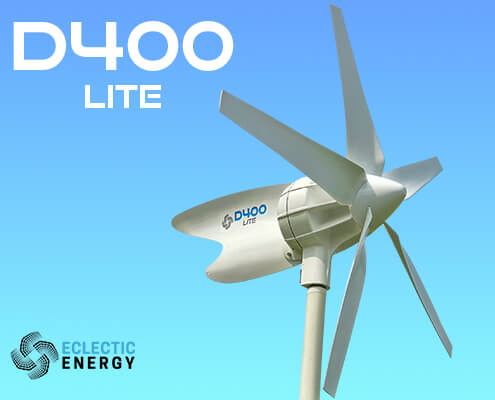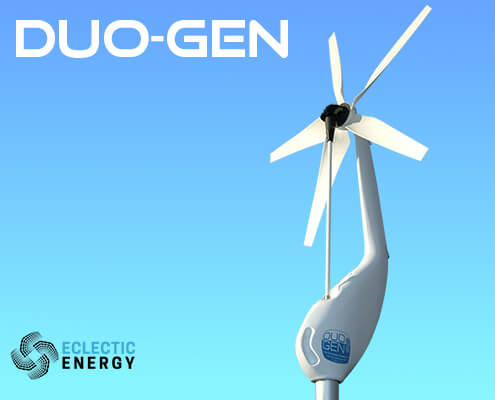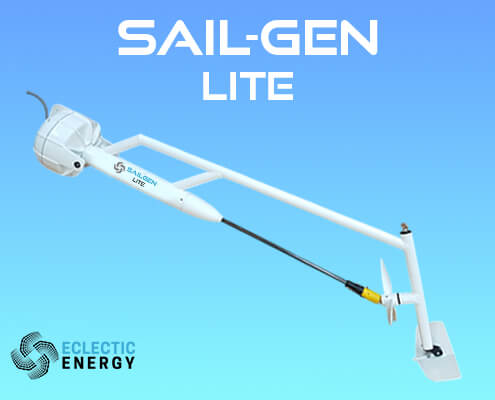Why choose to fit a water generator?
Water generators offer the best way to produce renewable electricity aboard a cruising yacht and are often capable of meeting all electrical loads whilst under sail on an extended passage.
Water generators extract energy from the boat’s motion through the water – essentially, this is still wind energy in that the water generator recovers a small percentage of the energy captured by the yacht’s sail plan.
The inertia in the yacht’s hull evens out the variations in wind velocity and direction, and the result is a very steady and constant power output from the water generator, in contrast to a dedicated wind generator, where the output will tend to fluctuate continually.
There is a belief that deploying a water generator will result in a significant loss of boat speed. Whereas they used to be some truth in this with the more recent design speed loss is minimal.
Which type should I buy?
There are three main types of water generator. The earliest designs use a heavy impeller or spinner attached to a long line. These devices were inspired by earlier mechanical logs as used by ships such as the Cutty Sark, and although these could work well, from a practical point of view they are very awkward to deploy and recover.
There is no satisfactory method to control the impeller depth, which will sink to the sea bed when stationary and rise through the water as boat speed increases. The impeller has a tendency to surface at higher boat speeds (i.e. 6 -7 knots) and then generation stops. As these systems use a long tow line, the parasite drag and subsequent loss of boat speed is higher than other systems, and typically, maximum power outputs are around 100 watts.
More recently, the ‘outboard leg’ type of water generator has been introduced. These are attached to the yacht with a system resembling a dinghy rudder fitting. As the generator is rigidly fixed at the transom, any vertical movement of the yacht’s stern is transmitted to the unit, so wave action and heel angle directly affect the depth of the water impeller. Also, the units rely on a mechanical ‘fuse’ in the hold down lines (which keep the impeller submerged) and this leaves the submerged leg vulnerable in the event of impact with flotsam. As the leg is held down at 90 degree to the water flow the resulting lever arm places great stress on the mounting point at the yacht and these have been know to fail unless the installation is sufficiently robust.
The ‘outboard leg’ type machines feature a small 3-phase AC alternator which is submerged below water. They therefore rely on the integrity of the seals to keep water out of the electrics. Also they tend to output high voltage 3-phase AC and require an external regulator unit to condition the power and make it suitable for battery charging. Should the electronics fail the unit will no longer charge the batteries.
Depending on the make and the model ‘outboard leg’ type generators weight between 8-18kg excluding mounting.
The third option is to consider Eclectics DuoGen or Sail-Gen Lite range which uniquely utilises a small wing or dive plane which controls the running depth of the water impeller.
Features and Benefits of Eclectics Water Generators
Eclectic approach to water generation is different to the competitors, and both Sail-Gen Lite and Duo-Gen, share the same operating principle which is well proven over hundreds of thousands of sea miles.
Eclectics water generators feature a small ‘hydro foil’ we refer to as a ‘dive plane’. The dive plane prevents the water impeller from surfacing in all but the most extreme situations. This also allows the water impeller to fly through the wave action at a constant running depth largely unaffected by wave action or the movement of the yachts hull. This results in a very steady consistent electrical output.
Both Duo- Gen and Sail-Gen Lite are mounted onto the yacht using the supplied alternator yoke and ‘c’ bracket assembly. Together, these form a gimballed mount and this allows both types of machine to pivot vertically and horizontally when deployed. These gimbals resolve and dissipate the bending and twisting forces produced by wave and steering action.
In the case of Sail-Gen Lite the diving plane is active so as soon as pressure is applied to the recovery lanyard the angle of the plane moves to a positive position making recovery of the unit easy and safe regardless of boat speed. Re-deploying the unit is equally straight forward.
Eclectic configuration means that the alternator is not submerged, and is therefore less liable to failure through water ingress. The alternators are transom mounted, the Duo-Gen at coaming height and Sail-Gen Lite lower down. A variety of mount options and hardware solutions are available to suit different yacht designs. The slow speed, permanent magnet alternator is robust, highly efficient and well proven. Featuring stainless steel shaft and bearings, powerful ferrite magnets and heavy copper windings, this unit is capable of sustained outputs in excess of 500 watts. The alternator outputs high quality DC and can be directly connected to a battery if required.
Both Duo- Gen and Sail-Gen Lite are built using high quality, corrosion-resistant materials, including cast aluminium impellers, carbon fibre driveshafts. Products are finished in high quality polyester powder coats and hard anodised aluminium.
Drag and the resulting speed loss from water generators are often over-stated. Drag from the Duo- Gen / Sail-Gen Lite is less than 15 kg at 6 knots, and typical boat speed losses at that speed are in the order of a tenth of a knot or less.






